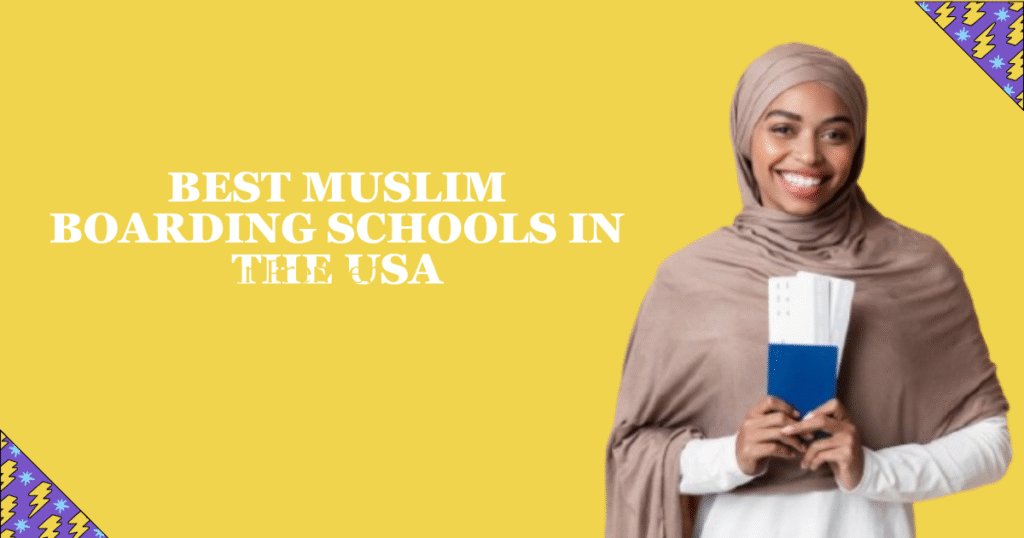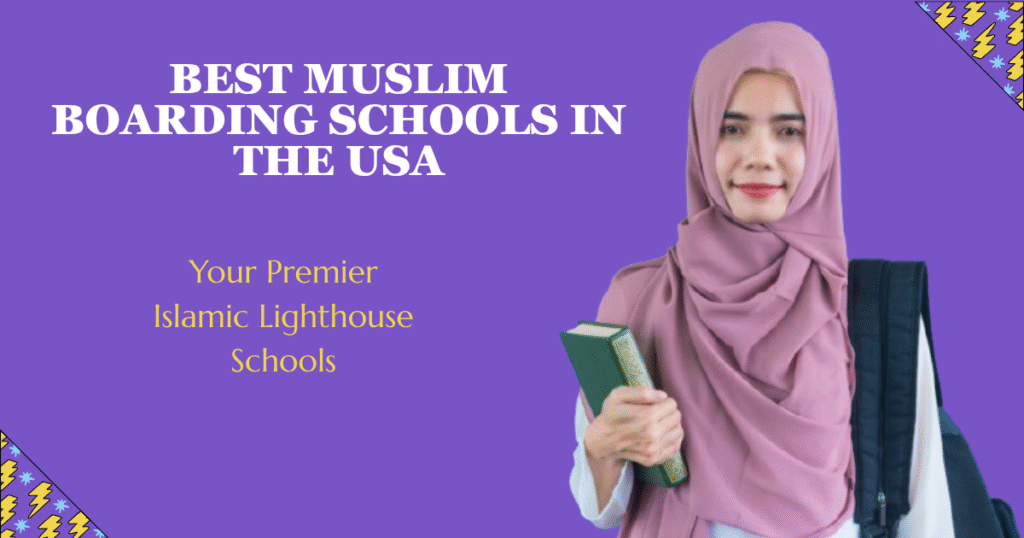Muslim boarding schools in the USA offer students a full-time Islamic and academic education. Students live on campus. They pray, learn Qur’an, and take standard subjects like math, science, and English. These schools support Muslim identity and academic growth. I remember visiting one school in Michigan. The staff spoke kindly to students. They taught both prayers and algebra in one day. That visit showed me how the two parts combine well.
The content below explains what these schools do, their history, daily life routines, curricula, notable institutions like Michigan Islamic Academy, School of the Ummah, Houston Quran Academy, Noor Ul Iman, plus accessibility, community links, and challenges.
Key Takeaways
- Muslim boarding schools combine religious and secular education.
- Students follow a fixed daily routine of prayers, academics, and Qur’an.
- Top schools include Michigan Islamic Academy, HQA, and Noor Ul Iman.
- Financial aid and community support help student access.
- Schools balance identity needs with modern learning tools.
Overview of Muslim Boarding Schools in the USA
Muslim boarding schools in the USA serve grades from middle school to high school. Students live on campus. They study Islam and academics. They join peers from distant areas. Parents choose these schools for safety, values, and faith growth.
Definition and Purpose
These schools provide a boarding setting combined with Muslim values and US curriculum. Students memorize Qur’an (Hifz), learn Arabic, follow prayers five times a day. They also study science, math, English, social studies. Purpose: build identity, faith, and prepare for college.
Historical Context and Evolution in the USA
Islamic schools grew from fewer than 100 in early 1990s to over 300 full-time schools today. Many were day schools. A few added boarding later. Some grew near mosques or in immigrant communities. These schools emerged to offer Islamic culture and learning at scale.
Educational Philosophy and Structure
Schools focus on moral character and academics. Class sizes often stay small for better attention. Students pray together. Teachers know students well. Schools aim that 90% of graduates attend college. They teach state standards alongside Qur’an and Arabic.
Integration of Islamic Values with Academic Excellence
Religious studies take about 30–40% of school hours. For example, Houston Quran Academy in Texas uses 40% for religion and also takes the STAAR test to compare academic strength. Their juniors achieved eight National Merit Scholars in one year. Research from Boston University shows students at Islamic schools identify strongly as both Muslim and American.
Daily Life and Routine in a Muslim Boarding School
Here is a typical daily schedule:
| Time | Activity |
| Before dawn | Fajr prayer, Qur’an review |
| Early morning | Academic classes (math, science, English) |
| Midday | Dhuhr prayer, Islamic studies |
| Afternoon | Academic classes continue |
| Late afternoon | Asr prayer, Qur’an memorization or Arabic |
| Evening | Dinner, Maghrib prayer, quiet study time |
| Night | Isha prayer, bedtime |
Key Programs and Curricula
Hifz and Quranic Studies
Students spend time each day memorizing Qur’an. Teachers guide pronunciation and understanding. Some students finish memorization in a year or two.
Academic Curriculum and Exam Preparation
Schools follow state standards. They cover math, English, science, social studies. Many boards prepare students for SAT, ACT, or state exams. Houston Quran Academy uses Texas STAAR test by choice. Noor‑Ul‑Iman in New Jersey averages high SAT scores and 100% college placement.
Extracurricular Activities and Personal Development
Schools offer sports, clubs, community service. Iman Academy in Houston requires 120 service hours before graduation. Clubs include debate, art, robotics, and charity drives.
Notable Institutions

Michigan Islamic Academy
Located in Ann Arbor, MI. Founded in 1985. Serves pre-K to grade 12. Offers academics, extracurriculars, prayers, and Qur’an classes.
School of the Ummah
A recent community venture. Focuses on building community ties and Islamic identity. Boarding model is emerging.
Houston Quran Academy
Located in Katy, TX. Offers K‑12 education. 40% of curriculum is religious. Administers STAAR exam, outperforms state averages. Eight National Merit Scholars in one junior class.
Noor Ul Iman School
Located in Monmouth Junction, NJ. Founded in 1993. Pre‑K to 12. Student-teacher ratio about 9:1. 100% graduates attend college. High SAT scores. Diverse student body.
Accessibility and Community Involvement
Financial Aid and Scholarship Opportunities
Schools offer sliding tuition scales, sibling discounts, and scholarships. Houston school offers staff children 50% tuition discount. Some schools help families through fundraising.
Community Partnerships and Volunteer Programs
Students join mosque-led community events. Many schools require service hours. Iman Academy demands community service before graduation.
Role of Donations in School Development
Donations support campus expansions and equipment. Many schools rely on community funding to grow facilities or add boarding wings.
Challenges and Opportunities
Balancing Religious and Secular Education
School leaders work hard to maintain both. Parents want strong identity and strong academics. Houston Quran Academy shows that model works.
Addressing Cultural and Diversity Issues
Student bodies include many ethnicities. Schools teach respect across cultures. Studies show students build strong identities as Muslims and Americans.
Enhancing Technology and Modern Learning Tools
Rural boarding schools may lack hi-tech labs. Many schools plan to upgrade IT, library, science labs. Use of tablets and online platforms is increasing.
Numbered List: Top Benefits of Muslim Boarding Schools
- Full immersion in Islamic values and faith.
- Strong daily structure and routine.
- High college matriculation rates.
- Safe social environment.
- Close teacher support due to small classes.
Bulleted List: Common Extracurricular Activities
- Sports: basketball, soccer, track
- Clubs: debate, arts, Quran competition
- Community service: soup kitchens, mosque events
- Academic clubs: robotics, science fair
Boarding School Guide Key Takeaways at a Glance
- Average U.S. boarding school tuition: $56,875 per year.
- Ages: Most kids start between 11 and 16.
- Financial aid and some free schools exist.
- Phone access rules vary between schools.
- Seven-day and five-day schedules are both common.
1. How much does it cost to go to boarding school?
- Most U.S. boarding schools charge $20,000–$75,000 each year.
- The average tuition is $56,875.
- Five-day boarding schools average $55,425; seven-day, $69,150.
“Parents invest not only in academics but in lifelong skills,” says education expert Jane Smith.
2. Is boarding school worth the cost?
Boarding schools offer:
- Small classes.
- Personal support.
- A close-knit community.
Many students build strong networks. College admission rates are high. Parents find that long-term benefits outweigh the cost for many families.
3. At what age do most kids go to boarding school?
Most students start between the ages of 11 and 16.
- Junior boarding schools start as early as 7 or 8.
- High schools: 14–16 is most common.
4. How much to send a kid/did/child to boarding school?
The cost is the same for all: Most pay between $20,000 and $75,000 per year. The average is around $56,000.
5. Best age to send/start boarding school?
Ages 11–13 work best for most. Kids this age adapt well and handle independence better.
“Middle school offers a gentle entry,” says counselor Amy Brown.
6. Are there free boarding schools in the US?
Yes. Some public boarding schools are free:
- Alabama School of Fine Arts.
- Illinois Math & Science Academy.
- SEED Schools.
These serve grades 7–12. Some state-funded options are selective.
7. Youngest age for boarding school?
Some schools accept kids as young as 7 or 8, but this is rare. Most join at 11 or older.
8. Are boarding schools expensive? How expensive is it?
Tuition is high compared to private day schools—most families pay $40,000–$75,000 per year, but some schools cost less. Scholarships help lower the net cost for some.
9. Do boarding schools allow phones?
Policies differ. Many schools limit phone use.
- Phones are often stored during the day.
- Some only allow use at certain hours.
- A few ban smartphones, offering basic phones instead.
10. How do parents afford boarding schools?
Families apply for financial aid and scholarships. Some use payment plans or education loans. Grants often go to households earning under $65,000–$75,000.
11. Can I get financial aid for boarding school?
Yes. Many offer need-based aid. Up to 40% of students get grants or scholarships. Early application helps.
12. How do I get my child into a private school for free?
Look for:
- Public charter boarding schools.
- State-supported magnet programs.
- Full scholarships at some private schools.
Apply early and provide proper documents.
13. Are kids who go to boarding school more successful?
Studies suggest these kids:
- Have higher college enrollment and graduation rates.
- Gain confidence and leadership skills.
“Boarding schools support independence and resilience,” states researcher Mark Allen.
14. How long do kids stay in boarding schools?
Most stay 1–4 years (grades 7–12). Some spend a “PG year” after 12th grade to boost college prep.
15. Why do most kids get sent to boarding school?
Common reasons:
- Strong academics.
- Extracurricular options.
- Family needs (e.g., parents move often).
- A supportive environment.
16. Are boarding schools 7 days a week?
Both seven-day and five-day schools exist.
- Seven-day: Students live at school every day.
- Five-day: Go home on weekends.
17. Do boarding schools have days off?
Yes. Students get:
- Weekends at home, five-day schools.
- Exeat weekends, half-term, and major holidays at seven-day schools.
- Summer, Christmas, and Easter breaks.
FAQ
Q: Are scholarships easy to get?
Scholarships are competitive but available. Apply early.
Q: Can international students attend?
Many schools accept foreign students. Check each school’s policies.
Q: Are meals included in tuition?
Yes, tuition usually covers meals, laundry, and boarding.
Q: Can students leave campus?
Most schools have weekend leave or special events off-campus.
What percent of Muslim students attend boarding Islamic schools?
Very few. Only about 1% of Muslim children attend full-time Islamic day or boarding schools.
Do these schools follow state curriculums?
Yes. Schools cover all required state subjects. Some take standardized exams like STAAR.
Do students feel American?
Yes. A BU study found students identify both as Muslim and American equally.
Are schools affordable?
Costs vary. Many offer scholarships, sliding scale fees, sibling discounts, and staff benefits.
Final Thoughts
These schools give students strong faith and academic grounding. Students grow as learners and Muslims. Parents gain peace knowing their children learn in a safe, caring space. I saw many students smile at dinner time after evening prayers. That warmth shows schools do more than teach subjects. They build character. If a family seeks both identity and education, these schools can fit well.

